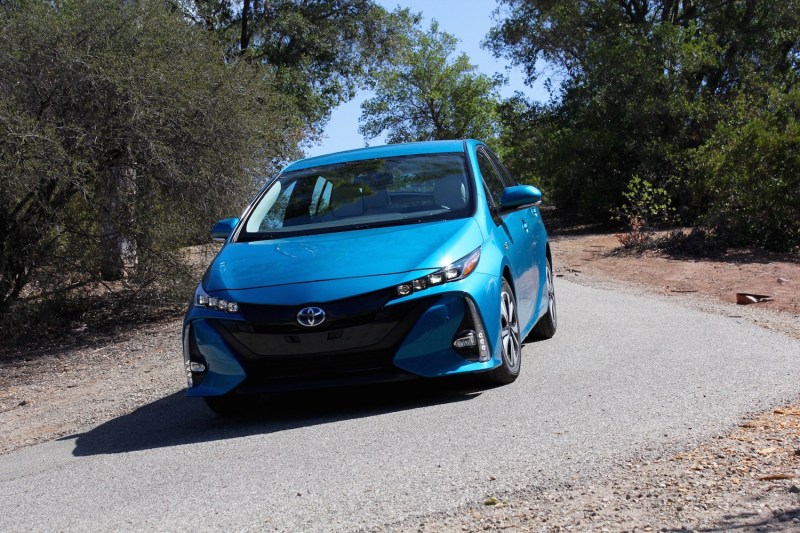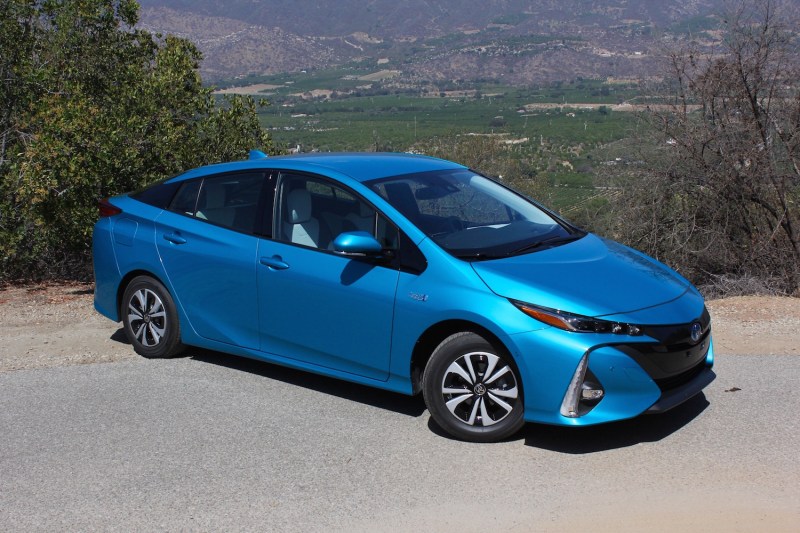By 2012, Toyota’s Prius liftback hybrid ruled the alternate energy car market. Affordable, conservatively styled, and efficient, the Prius was a no-brainer purchase for those who hated the weekly trip to the gas station. But the once-novel gas-electric hybrid concept was no longer the innovation du jour. Pure electric vehicles like the Nissan Leaf had arrived without any reliance on fossil fuels.
Yet EVs were deeply flawed. Micro ranges and lofty price tags discouraged the majority of environmentally conscious shoppers from jumping aboard the electron bandwagon. Toyota’s solution? A Prius PHEV (plug-in hybrid electric vehicle). With a short, all-electric range, drivers can hold off on fuel consumption for brief trips and extend overall tank range on longer outings.
Toyota’s calculated maneuver kept the money-printing machine at full power…for a time. Four years later, Toyota’s standard Prius liftback is more efficient (and questionably styled) than ever, but the hybrid buzz is fading fast. Advances in battery technology have cut EV prices and increased ranges significantly. The transition is fast approaching, yet Toyota sees no need to change its formula.
The 2017 Prius Prime, therefore, must either be a holdout tactic or precisely the right move. After our 2017 Toyota Prius Prime first drive, I can say it’s a bit of both.
Baby Steps
Under the hood, we’ve got a 6.2-liter supercharged V8… Nope, just kidding. The same 1.8-liter Atkinson cycle four-cylinder from the regular Prius (or “liftback,” in Toyota speak) is paired with a larger 8.8 kWh lithium-ion battery and an electric motor for a combined 121 horsepower. Unlike the liftback, the Prime adds dual-motor functionality, meaning a one-way clutch engages both the generator and electric drive motor to improve performance.

This setup equates to a total driving range of 640 miles (100 more than the 2012 PHEV), fuel economy estimates of 55 city/53 hwy/54 combined mpg, and an MPGe rating of 124. It’s worth noting that the most efficient Prius liftback – the Eco – bests the Prime’s numbers by 2 mpg across the board, but it can’t travel on electricity alone for longer than a mile or so. Speaking of, the Prius Prime will now coast up to 25 miles without waking its gas engine, beating Toyota’s estimates but still coming up short of the Volt’s 53-mile figure.
Despite the additional source of motivation, the Prime matches its non-PHEV sibling in a 10.5-second sprint to 60 mph, due largely to an additional 300 pounds of weight. To fully charge the Prime’s battery via a standard 120V outlet, you’ll need 5.5 hours of down time. Should your office provide 240V charging stations, the Prime will be at capacity in 2 hours and 10 minutes. When pressed about DC10 (level 3) charging, Toyota said it doesn’t currently see the need for a rapid-charging option. My hunch: the automaker won’t offer a quicker method until it does away with the gas engine entirely.
In addition to Normal, Eco, and Power drive modes, the Prime features EV, EV Auto, and HV functions. Each mode is fairly simple: EV saps available electric juice until dry; EV Auto prioritizes electric power unless under heavy load; and HV works like a traditional hybrid, blending gas and electric power. While most of these changes are incremental, perhaps the Prime’s greatest advance is the ability to travel in EV mode at speeds up to 84 mph.
Good Tech, Bad Tech
During the Prime’s launch presentation, Toyota emphasized several technology enhancements unique to the Prime, but its inclusion of Toyota Safety Sense on all trims is by far the most noteworthy. Nothing about TSS-P is innovative. Pedestrian detection, automatic braking, lane-departure warning with steering assist, adaptive cruise control, and automatic high beams are available on a broad spectrum of vehicle models in 2016, but only some luxury vehicles standardize such equipment.
Why is this such a big deal? Beyond the fact that driver distractions are at an all-time high, Toyota’s move to include lifesaving technology in an affordable vehicle will pressure competing automakers to follow suit. Toyota also announced that TSS-P would become standard on all Toyota vehicles within the next two years.

The 2017 Prius Prime comes equipped with a generous list of convenience technologies. Goodies native to the entry-spec Prime Plus include automatic climate control, a 7.0-inch infotainment system with Entune audio, navigation, and Toyota apps, Bluetooth, a 4.2-inch color TFT display, two 12V ports, one USB connection, backup camera, and push-button ignition. Stepping up to the Premium introduces an 11.6-inch tablet-style screen. Fully loaded (Advanced) models layer on a head-up display, JBL 10-speaker audio system, remote A/C (to heat or cool the cabin prior to departure), and intelligent parking assist.
Unfortunately, the Prime struggles with quantity over quality when it comes to tech. Despite the prodigious screen size, Toyota’s tablet has little in common with Tesla’s. While simple to use, thanks to smartphone-like pinch and zoom functions, the low-resolution screen and glare-obstructed surface feels immediately outdated. Grainy screens are forgivable, but less so is the single USB port. In the age of multiple devices, even a single passenger is likely to need more than one input at some point, and the situation gets worse with multiple occupants. An adapter simply shouldn’t be required in a 2017 model year vehicle.
Mixed Emotions
Toyota may be an automotive behemoth, but even the biggest brands must yield to consumer feedback. Such is the case with the Prius Prime’s styling. The 2016 liftback redesign was unquestionably a departure from its mild predecessor, but few would argue that Toyota’s designers pulled off the transition. Though Toyota may not admit their mistake, the Prime’s specific styling tweaks suggest the message was received.
At the front, Mirai-esque quad projector beam headlights flank a more traditional pointed acrylic grille. At the rear, a new “double wave” rear window and connected LED taillight bar help distinguish the Prime much more than its PHEV predecessor. The Prime is also 4.2 inches longer – extending the front and rear overhangs, not the wheelbase – than its liftback sibling. 5-spoke alloy wheels round out the standard styling cues. These changes distill some of the Prius’s most objectionable design traits, but they don’t transform the car into a handsome shape.

Inside, the Prius Prime claws back some aesthetic respect. A tall greenhouse and thin pillars give the sense of ample space. SofTex seating surfaces (Premium and Advanced trims) and soft-touch materials elsewhere in the cabin hints at luxury. Due to its larger battery, the Prime is configured exclusively as a four-seater, replacing the rear center seat with a small cubby. Ride quality, aided by a new double-wishbone rear suspension, is comfortable at any speed, but wind noise becomes pronounced on the highway.
The Right Fit
Like the Prius liftback, Toyota hides modest technology advancements beneath the Prime’s unique bodywork. Twenty-five miles of electric driving is enough to get most Americans to and from work, 54 combined mpg is enough to free drivers from gas price woes, and 640 miles of total range is far better than even the most efficient petrol or diesel powertrain.
If $25K EVs with 300+ miles of range were on sale today, or if the Prime was overpriced, Toyota would have a problem. But the 2017 Prius Prime starts at $27,965 (including destination) and ultra-affordable, long-range EVs are still a couple years off. Until the market truly changes, Toyota’s hybrid and new PHEV lay a wide net to capture everyone except the earliest adopters (who are welcomed into the Mirai’s stubby arms).
Put simply, Prius buyers are pragmatic, and a $21K plug-in hybrid (assuming maximum fed and state tax incentives) couldn’t be much more of a logical buy.












